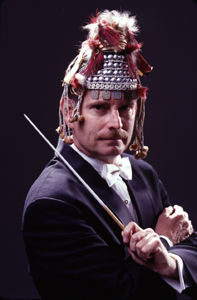![[Metroactive Music]](/gifs/music468.gif)
[ Music Index | Santa Cruz | Metroactive Home | Archives ]
Clutch Time
Saxophonist Bill Trimble pushes the Santa Cruz Symphony to fine finish in program of tricky classical pieces
by Scott MacClelland
Part two of last Saturday's Santa Cruz Symphony program emerged as the winning half. Prokofiev's Lt. Kije Suite and Berlioz' Roman Carnival Overture restored the orchestra's full confidence and, therefore, its high standards of focus, clarity and spirit. One possible source of that confidence was the saxophone playing of Bill Trimble, a splendid musician who has been known to rescue orchestral wind sections from themselves by sheer force of example. Of course, Trimble appears only on those rare occasions when symphonic literature includes prominent parts for his instrument, in this case the Prokofiev.
If Trimble set a standard of authority, in gorgeous tone no less than stylish technique, he soon became one among many. Prokofiev's spoof is a masterpiece of wit and imagination, a score of startling invention, which long ago transcended its original role as a motion picture soundtrack. (The same thing happened with his music for the Eisenstein epics Alexander Nevsky and Ivan the Terrible). Indeed, it is hard to understand why this composer seems to have disappeared from the radar except for two or three favorites, this one among them.
Larry Granger's program was organized around an enlarged brass section employed in all four scheduled works. Contrary to the opinion of a few, however, all classical music is not created equal. Some plays itself; however, most needs actively to be restored to life with each new iteration, and some is mined with traps. Such a work is the overture from Wagner's opera Tannhäeuser, a hot-air balloon of faux religiosity that enriched the composer more than his swooning fans. (Actually, it also enriched the composer's father-in-law, Franz Liszt, who reduced the overblown score to a bravura piano display piece.) As such, anything less than absolute sincerity reduces it to a parody of itself, and even that play is no guarantee of success.
The reading of it which opened the concert delivered plenty of sonic excess, but no theatrical context. Absent that latter component by conductor Larry Granger, and sufficient precision by his orchestra, the result was, as one concertgoer was heard to remark, lugubrious. Like it or not, this is ultimately program music. Ignoring the 'program' only highlights its musical shortcomings. What the conductor needed to supply was a personally expressive plan for Wagner's dramatic grandiloquence. What the orchestra needed to supply was rhythmic exactitude and razor-sharp entrances. Neither was forthcoming, leaving only an aftertaste of banality. While Wagner gets to carry his share of blame for these cheap thrills, one wonders how he still manages to draw conductors to it.
One explanation is undoubtedly the large brass choir which gets to intone the Sacred Chorale, over and over. Fortunately, the Entry of the Guests from the same opera, a work that comes a lot closer to playing itself, redeemed the assembled talent through its festive fanfares and processional dignity.
Chen Yi's violin concerto, Chinese Folk Dances, returned erstwhile concertmaster Terri Baune as soloist in a work she premiered two years ago in San Francisco. Its idiosyncratic three movements make as much of the small detail as of the big gesture. In the outer movements, the solo instrument is often absorbed into the busy and colorful orchestral fabric rather than set apart. Except for the lengthy cadenza in the final movement, the soloist otherwise got her best exposure in the middle movement, "YangKo," which is based on a regional folk dance from northern China. In this case, the violin spins a long free-floating melody over a rhythmic pattern of vocal and whispered utterances from the orchestral musicians. When the violins finally join in, they and the soloist continue by playing harmonics, those silvery melodies and arpeggios fashioned only by touching the strings lightly at specific nodes. With vigorous dance rhythms dominating the outer movements, this idyll proved to be the heart of the work and the soloist's moment to make the piece her own. The opening movement busily captures the lion's dance familiar at Chinese New Year celebrations. The finale went to western China where the flavor of Persian music permeates the writing. Since the work is complex and deserves another hearing, it would have been a good choice to include on a program that repeated in Watsonville. The orchestra, as well as the soloist, would have stood to gain added polish from another performance.
The Berlioz that closed the program was all sizzle and sparkle with the orchestra sounding its symphonic best. The big cor anglais solo of Diane Machado-Wyant set an excellent tone for those luscious long-limbed Berlioz melodies.
[ Santa Cruz | Metroactive Central | Archives ]
Copyright © Metro Publishing Inc. Maintained by Boulevards New Media.
![]()

Mad Hatter: Larry Granger only wore that thing, like, once in his entire life, but we will never let him forget it.
From the April 9-16, 2003 issue of Metro Santa Cruz.